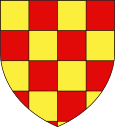Annonay
| Annonay | ||
|---|---|---|

|
|
|
| region | Auvergne-Rhône-Alpes | |
| Department | Ardèche | |
| Arrondissement | Tournon-sur-Rhône | |
| Canton |
Annonay-1 Annonay-2 |
|
| Community association | Annonay Rhône Agglo | |
| Coordinates | 45 ° 14 ′ N , 4 ° 40 ′ E | |
| height | 270-746 m | |
| surface | 21.20 km 2 | |
| Residents | 16,345 (January 1, 2017) | |
| Population density | 771 inhabitants / km 2 | |
| Post Code | 07100 | |
| INSEE code | 07010 | |
| Website | Annonay | |
 Annonay - location view |
||
Annonay ( Occitan Anonai ) is a southern French town in the north of the Vivarais and a municipality in the department of Ardèche in the Region Auvergne Rhône-Alpes . With 16,345 inhabitants (as of January 1, 2017) Annonay is the largest city in the department, but not the seat of the prefecture . This is located in the much smaller Privas .
Location and climate
The city of Annonay is located on the Cance River a few kilometers west of the Rhône Valley at the foot of a hill at an altitude of about 360 m . Annonnay is the hub of important trade routes and is located approx. 75 km (driving distance) south of Lyon and approx. 46 km southeast of Saint-Étienne . The municipality is located on the edge of the Pilat Regional Nature Park and is associated with it as an access point. The climate is temperate to warm; Rain (approx. 805 mm / year) falls over the year.
Population development
| year | 1800 | 1851 | 1901 | 1954 | 1999 | 2017 | ||
| Residents | 5,550 | 13,214 | 17,490 | 16,201 | 17,522 | 16,345 | ||
| Sources: Cassini and INSEE | ||||||||
economy
In the past, leather processing was the city's main industry; Even today, expensive leather is produced in the Tannerie d'Annonay according to old tradition and sold nationwide. Most of the economically active residents work in the automotive industry or in paper mills, but also industries for the production of plastics, textiles and medicines are located in Annonay. A dam on the Ternay in the northwest of the city was built to create a water reservoir and is used to store water for industry and households. Agriculture and viticulture traditionally determine the economy in the region.
history
The place name could be derived from the Latin term Annoniacum , which means residence of Annonius . It could be a rich Roman.
In the Middle Ages, Annonay was home to many powerful families and pilgrims stopped in the city on their way to Puy-en-Velay . The place was looted several times and also suffered from the Hundred Years War , so that a city wall had to be built.
In the first half of the 16th century, the conflict between Catholics and Protestants determined life in the city. The beginning of the Huguenot Wars in 1562 was therefore a catastrophe for Annonay as well, in which the nearby Pugneux Castle was also destroyed. The years 1585/86 were especially bad for the population, as the plague and famine claimed many lives. Only after the Edict of Nantes of 1598 did calm and prosperity return to Annonay.
Attractions
- Former castle gate from the 17th century, which was partially destroyed in 1968
- Pont Valgelas ; Bridge from the 14th century, the entrance to the city in the Middle Ages
- Voûtes Soubises : 12th century street that goes past parts of the old city walls
- 17th century church
- octagonal bell tower of Trachin, relic of a priory from 1320
- Rue de Trachin : civil residence in the 17th century
- Place Mayol with a tower from the 16th century
- Sainte-Marie convent built on the foundations of the Château de Malatour from 1630
- Rue Béchetoille with the royal bailiwick from 1700
- Tour des Martyrs from the 17th century: Remains of the city wall, from which men sentenced to death in the Middle Ages were thrown into the deûme below
- Rue de la Poterne with the official building of Nicolas du Peloux, the governor from 1577
- City theater from the 19th century
- Église Notre-Dame , 1904–1912
The first public demonstration of a hot air balloon ( Montgolfière ) by the Montgolfier brothers took place in Annonay on June 4, 1783 . Two more balloon launches followed in the same year.
Personalities
- Pierre Bertrand (1280–1349), cardinal, theologian and canon lawyer
- Joseph Michel Montgolfier (1740–1810), inventor of the hot air balloon, the Montgolfière
- Jacques Étienne Montgolfier (1745–1799), inventor of the hot air balloon, the Montgolfière
- Louis Monneron (1742–1805) is considered to be one of the greatest entrepreneurs at the end of the Ancien Régime
- Augustin-Joseph-François Monneron (1756–1824), entrepreneur, politician and banker
- Marc Seguin (1786–1875), engineer and inventor of the iron rope suspension bridge and the steam tube boiler
- Auguste Bravais (1811–1863), physicist and co-founder of crystallography
- Charles Fillingham Coxwell (1856-1940), translator
- Joseph Canteloube (1879–1957), composer and musicologist
- Roger Dumas (1932–2016), actor and songwriter
Town twinning
- Backnang in Baden-Württemberg , since 1966
- Chelmsford , Essex , since 1999
- Barge in Piedmont , since 2001


